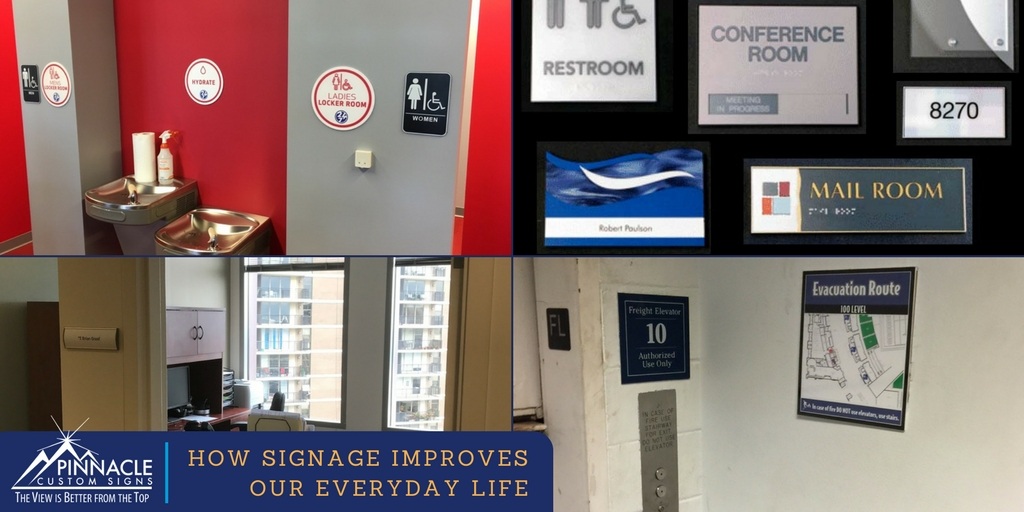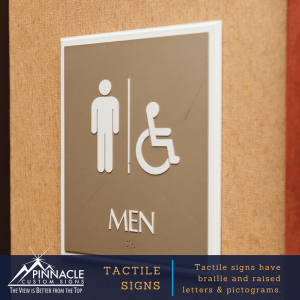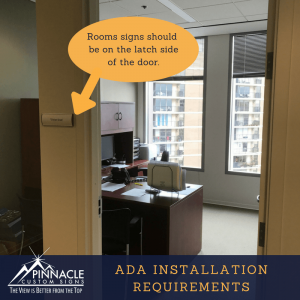When you are traveling – whether it’s to a meeting downtown or to another country – you can take comfort in knowing that you’ll be able to find essential services. This is because of the Americans with Disabilities Act and the ISO.
ADA signage doesn’t just help those with disabilities. It helps everyone quickly see and understand instructions about where to find emergency exits, bathrooms, first aid kits, telephones, and so much more. By requiring every business to have compliant signage, we create a safer environment for all people but most especially for those with disabilities.
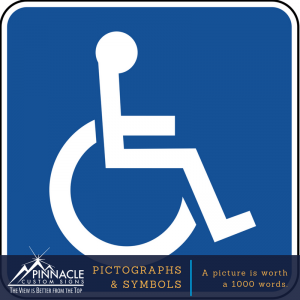 The Seen and Unseen
The Seen and Unseen
Disabilities can range from being in a wheelchair to having visual or hearing impairments to a wide range of invisible disabilities, like dysautonomia, chronic pain, chronic fatigue, etc. You can also have a temporary disability, like a broken foot or other short-term disabilities.
The needs of individuals with disabilities can vary, which is why the ADA Standards for Accessible Design was created – to help you design and install appropriate signage.
Making things easier to see.
Glare is annoying no matter what you are doing. It makes it especially difficult to read and understand signage. Signs that have a matte finish and a high contrast between the color of the letters or symbols and the background will help improve the visability.
Making things easier to read.
All jokes about Comic Sans and Papyrus aside, the font that you use for your signage is very important. From an ADA design standpoint, the font that you use needs to be sans-serif and the spacing between the letters and the words needs to watched carefully.
When you condense words, it makes it harder to read. Sans-serif fonts – like Arial, Helvetica, and others – are easier to read than more serif fonts, like Times New Romans, or decorative fonts, like Great Vibes.
The exception is with your logo; Disney’s logo uses a decorative font, but it’s easily recognizable because it’s part of the brand image. Find a sans-serif font that complements your logo’s font and use that in your signage.
Worth a 1000 Words.
Pictograms and symbols are able to convey meaning to anyone – no matter what language they speak. It’s a way of instantly telling people an idea. For instance, the International Symbol of Access is used around the world to indicate handicapped accessible services.
It is important to educate people about what different symbols and pictograms mean in order to ensure universal understanding. Many symbols we learn through normal interactions – like the symbol for restrooms. Others, we have to learn on our own or can easily deduce the meaning of, like no swimming signs.
A difference you can feel.
Visual impairment effects over 10 million people in the United States. Using tactile letters and braille will aid visually impaired individuals. All signs for permanent use rooms, areas and other key informational signs are required to use Grade Two Braille, also called Literary Braille.
Literary Braille is a “contracted” form of braille that is used in literary circumstances, like in books and on signs. This is different from Alphabetic Braille because it allows for contractions, much like when we use “don’t”.
Just like with the fonts you use in a sign, the Braille you use also has requirements. It must be domed shaped, spaced just right, and with capitalization only where absolutely necessary.
Knowing where to find it.
Imagine being blind and trying to find a room sign. How do you know where it is?
That is one reason why ADA signs have specific installation and mounting requirements. You want people to know exactly where to “look” for the signs. Rooms signs need to be on the latch side of the door and be 48” to 60” above the floor. And all overhead signs need to be 80” (6ft 8in) from the floor.
What Signs Do You Need?
That is a tricky question. Every business will have different sign requirements when it comes to what kinds of regulatory signs you need. Restroom signs, handicapped access points, and a few others are universal but other signs, like for safety, are not. To find out what signs your business needs, contact your local building code authority.
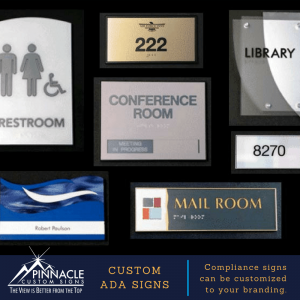 Designing ADA Signs
Designing ADA Signs
While there are some restrictions, you have the ability to customize ADA signs. You can match the design of the signs with your branding while keeping it high contrast and matte finish and use a font that complements your branding. You also have the option of using a variety of sign materials, like wood, PVC, and metal. Consult with a custom sign designer to ensure that your sign meets the ADA requirements.
Contact A Sign Professional.
Pinnacle Custom Signs can help you design, manufacture and install any custom signage your business needs. We work with you from day one to ensure that you get the best sign. Let us help you figure out the building codes and ADA requirements! Contact us today to get started!






